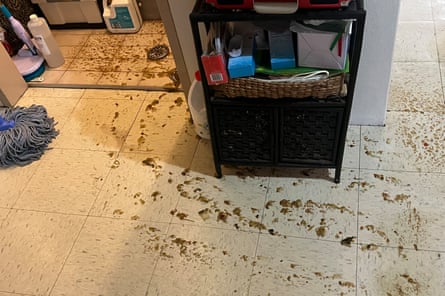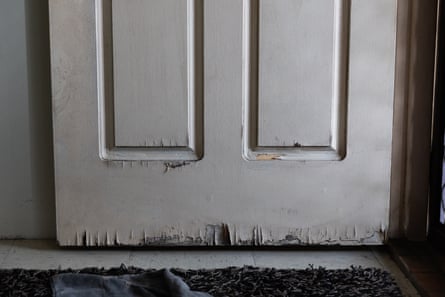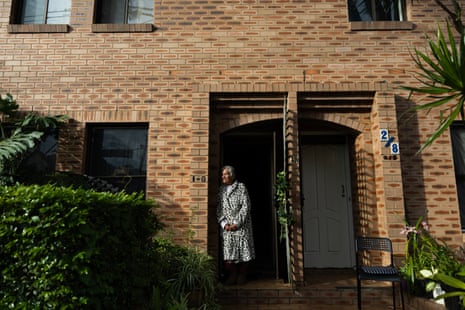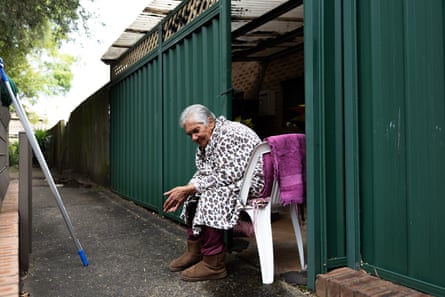Earlier this month, Carol Edwards woke to find the entire downstairs floor of her inner-Sydney terrace house covered in human excrement.
Faeces, urine, and balls of toilet paper from her neighbours’ homes had bubbled up from a drain in her laundry cupboard and spilled across the floor of her kitchen, past her dining table, through to the lounge – almost to the front door of her Alexandria home.
That 6 June morning wasn’t the first time sewage has flooded her home. In fact, she says it has happened more times than she can count in the 30 years she has lived in the housing commission property.

Edwards, 78, says her home has been flooded – sometimes with her neighbours’ sewage, sometimes with grey water when they run their dishwasher or washing machine – dozens of times. Friday was the third time that week alone.
“It just gurgles from the laundry, comes up like a fountain,” she says. “There’s faeces everywhere sometimes.”
Nicole Beaver, one of Edwards’ neighbours, moved into the area in October and checks in on Edwards most days – dropping over meals, helping her clean up and having tea together.
Beaver estimates that as well as the three flooding incidents during the first week of June, she has witnessed nine or 10 more since October last year.
Edwards says: “Ever since I’ve had this place, I’ve had nothing but floods and every time, I’ve always rung maintenance, the plumbers come out and do their job, they go, and it starts again.”


‘After seeing shit on your floor, who wants to eat a meal?’
For Edwards, her home being routinely flooded has an enormous effect on her quality of life.
When she came downstairs two weeks ago she slipped in the mess, falling hard.
Neighbours have called ambulances for her numerous times – including once last week – when sewage spewing from her drain caused her to have a panic attack.
“Oh, it’s terrible,” she says. “Soon as I come down to see water everywhere I start to panic and I start to shake. I’ve been at the hospital a couple of times.”
The house is cold. She has a number of large rugs that could cover the tiled floor, but they are folded up and balanced on top of dining chairs. “I can’t afford to get those wet, they’re too hard to get dry,” she says. “But it’s so cold after you’ve been flooded in here.”
Edwards’ own toilet often backs up as well. As she can never predict when it will work and when it won’t, she is now too afraid to use it and will go to the local pub instead, which has affected her health.

“I can’t have a decent feed,” she says, which is partly due to her toilet access and partly due to losing her appetite.
“After seeing shit on your floor, who wants to eat a meal, you know?”
Homes NSW ‘deeply concerned’
Each time the flooding occurs, Edwards does the same thing: mops up the mess – her home is full of drying mops – and calls the urgent maintenance number provided by Homes NSW, who manages public housing properties. Homes NSW sends out a plumber to unblock the drain.
When asked how many times she’s complained over the years, she says, “I’ve lost count.” Would she have called dozens of times? “It would be. Minimum.”
Homes NSW says it has records of three requests for urgent repairs at Edwards’ property since 1 July 2024. They all occurred in the last six weeks.
But Edwards and her children dispute this, saying the number is higher. Homes NSW did not provide records for calls before 1 July 2024.
Edwards claims that for the last 20 years, public housing officials have failed to resolve the underlying issue: tree roots from large trees in the lot behind the row of public housing terraces.
She says plumbers have told her for years that tree roots have infiltrated the pipes there.

A spokesperson for Homes NSW said the agency “responded immediately to each of these reported incidents by dispatching licensed plumbers to address the cause of the blockage”.
“It has taken time for the plumber to identify the source of the blockage, given the age of the property and neighbouring infrastructure.
“A CCTV inspection has now been undertaken across the entire sewerage system in the street. This has identified tree roots and accumulated wet wipes as the cause of the obstruction.”
Homes NSW claimed that the pipes were “thoroughly cleared using a root cutter and jet blaster to prevent further overflows” on Friday 6 June.
But Edwards’ property flooded again on Tuesday 10 June, Beaver says, though Edwards did not report this to Homes NSW. “She was just too fed up,” Beaver says.
after newsletter promotion
Homes NSW said they were “deeply concerned” about Edwards’ experience.
“We understand how distressing and disruptive this has been, we’ve offered the tenant alternate temporary accommodation and are committed to resolving this issue permanently.”
Many have given up on expecting government help
“I wish I could say that this story surprises me, but it doesn’t,” says Ned Cooke, the tenancy team leader at the Redfern Legal Centre. “The pattern of that story sounds very familiar.”
Cooke says decades of neglect of public housing has led to tenants “living in public housing in substandard and potentially dangerous conditions”.
About 10% of his team’s workload consists of public housing tenants dealing with repair and maintenance problems, Cooke says.
Many can get immediate repairs done, but the bigger structural issues – a leaky roof replaced, mould eradicated, electrical works sorted – often go unfixed for months or years.
Last year, the NSW government committed $1bn to repairing 30,000 public housing properties, saying that repairing the declining public housing stock was a key priority.
“We have a public housing system with over 100,000 properties, many of which have longstanding maintenance issues. We’re working every day and property by property to deliver better support to our tenants, but with a portfolio this large it takes time,” the NSW housing minister, Rose Jackson, said.

“When I hear stories like Carol’s I know we still have work to do, it isn’t acceptable and I’m just more determined to keep working to turn things around.
“When we came to government we found a public housing system that had been neglected and gutted. Homes were being sold off to fund basic maintenance and tenants were left waiting while the system fell apart.”
As at 26 May 2025, the Homes NSW maintenance team has completed 371,000 work orders, at a total value of $496m. The team was also on track to complete capital upgrades on approximately 7,500 properties, totalling $223m by 30 June 2025.
The Minns government said in 2024 it would establish a new response centre to take back management of public housing maintenance and repairs from the private sector.
Cooke said that it was too soon to tell if the Minns’ government’s stated focus on repairing public housing was making a difference to tenants.
But Beaver says the issues have been going for so long and the properties are in such bad repair that many have given up on expecting help from the government.
“People just give up and they save all their money and they do it themselves,” says Beaver. “Or they just live like that, they get used to living in those conditions. It’s really rough.”
Sewage not the only issue
Edwards, who was born in Bourke and moved to Sydney aged 16, worked as a cleaner and cook until she retired.
She is house-proud, walls decorated with pictures of Elvis and her own “diamond art” which she does by placing tiny coloured crystal beads on canvases to form pictures of flowers, a tiger, the Eiffel Tower.
“It’s my pride and joy, this little place, but I just can’t do it any more.”

She’d like to move to a ground-floor unit that is appropriate for someone approaching 80.
As well as the sewage issue, her current house has stairs with no hand rail, and she has to swing her legs over a bathtub to get into the shower. She has put a milk crate into the bathtub as a makeshift seat so that she can wash herself more safely, but it is not a long-term solution.
A spokesperson for Homes NSW said: “We understand that our tenant wishes to relocate. Our team received her transfer request on Tuesday June 10 and will work with her on a more appropriate housing option.”
But her son, Jamie Dempsey, wants to make sure that whoever moves into the property next does not face the same issues.
“I don’t want Mum to move out and they put another person in and it happens to them.
“Just imagine you wake up every morning and you come down the stairs and you don’t know if there’ll be faeces all over your kitchen floor ... I want them to look at it as a human being and say: what if this was your mum – cleaning up faeces and urine again and again.”

.png) 3 months ago
25
3 months ago
25

















































